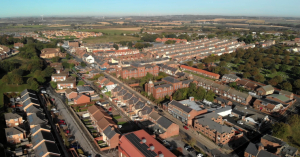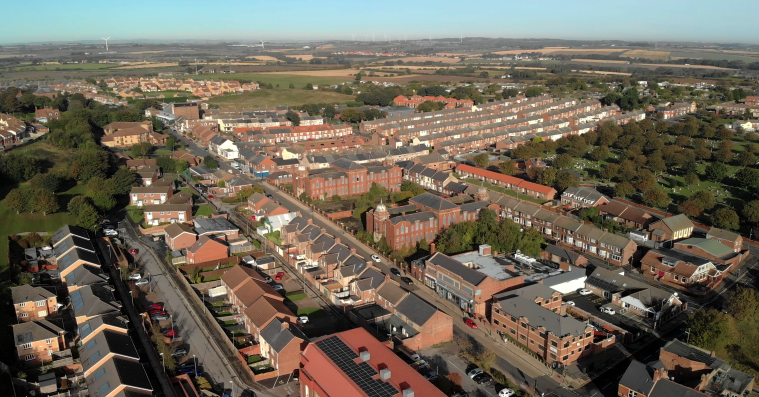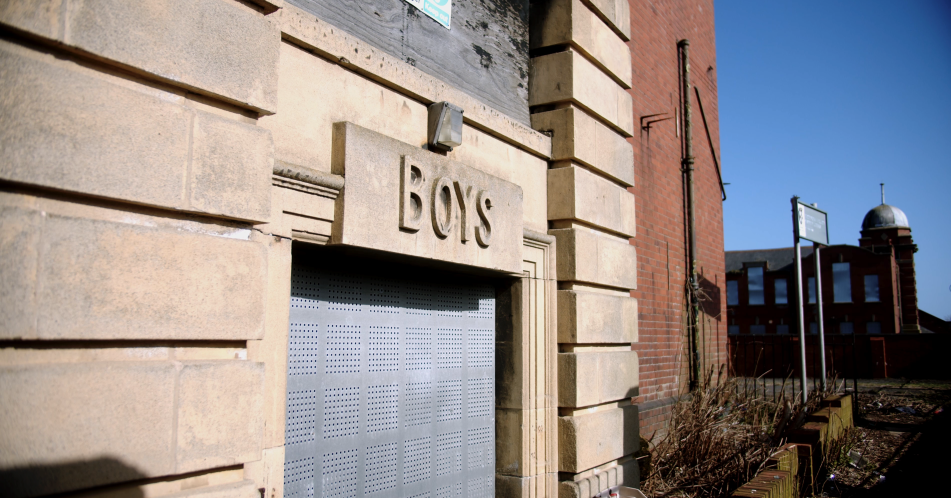
'The School on Seaside Lane': An interview with film-maker Carl Joyce
Mike Quille interviews Carl Joyce, maker of the award-winning short film The School on Seaside Lane. Below is the trailer...
What inspired you to create 'The School on Seaside Lane?' Was there a personal connection to Easington Colliery or the school's history that motivated you?
The initial idea came to me during the first Covid 19 lockdown, I read a local news article about Durham County Council buying the school back from the private development company that owned it for £50k and their plans were to demolish the building.
I’m originally from Horden Colliery, the village next to Easington, and I went to Easington Comprehensive School in the 90’s, so I was familiar with the school and its importance to the area. Whenever we’d pass the school on the bus I always remember the playground looked so full of life, the children always looked so happy there. I always wondered why they had a separate entrances for boys and girls.
I remember the school closing around 1997 and standing empty. Over the years it became vandalized and eventually it got boarded up, the playground became overgrown and the pigeons moved in. There was always a rumour that the school was about to be renovated but it never happened. People in Easington Colliery became sick of it, it was a black cloud preventing people moving on from the past.
When I read about the plans for the school to be demolished I felt sad that people were celebrating the end of the school. This was a school that had been through wars, it had educated most of the miners in Easington along with their children & grandchildren. This is what motivated me to make a film about it, it seemed vital to document positive memoriesof the school before it was too late.
Can you talk about the artistic choices you made in the film, such as the use of slow-motion sequences and poetry narration? How do these elements help convey the film's message?
I wanted to use slower sequences to give the audience time to absorb the messages and reflect on their own past experiences. I don’t think you necessarily have to have gone to that school to be able to relate to the stories and unpick the messages from the interviews. Another reason was to juxtapose the harshness of the demolition against the softness of the poem and archive footage, to heighten the audience’s emotions.
The poem was a happy accident. I went to interview Chris Robinson (the woman who describes the village as fractured like a crack in a coal seam) and she told me she’d written a poem about the school after she heard the school was going to be demolished. I asked if I could use the poem in the film and she agreed, so we set up a makeshift audio booth and I recorded her reading the poem there and then.
The film shows multiple shots of estate deprivation and buildings left to rot. What was the impact you wanted these visuals to have on the audience?
My initial idea was simply to make a record of the school for posterity, but it quickly became more than that. I was aware of the issues Easington had, just like Horden had/has when I lived there, but being on the streets and talking to people gave me a stark reminder of the massive impact that the closure of the pits and the loss of jobs and general deindustrialization has had on the area.
So my plan for the film quickly shifted, after the first couple of days filming. The school became a metaphor for the village – a once grand building left to rot and ruin, just like the village itself.
At the same time I wanted to be respectful to the people who lived there. I knew how important it was to get the balance right, to document the hardship and suffering but to do it in a dignified way – the people who live there are proud. There were many interviews where people said quite harsh and derogatory things about the village which I didn’t include in the final edit. After showing the completed filmto people in Easington, I’ve not had any negative feedback, so I feel like I got it right.
You interviewed several local residents who described the community as fractured and the area as an eyesore. How did you approach gaining their trust and encouraging them to share their stories?
I think being from the area helped to break down some of the initial barriers. People are wary of outsiders in places like Easington, so when they hear you’re from the local area and hear you speak with the same accent, people tend to open up more. When I was on the street filming the more spontaneous interviews, it was also quite easy to find people to chat to me on camera. People had a lot to say about the school and they had strong feelings about it, so once you asked them their thoughts on the school they opened up.
I found the interviewing the easiest part, everyone I spoke to had an emotional pull towards the school, people either went there themselves or had a family member who were pupils.
The demolition of the school and the closing of the pit are central themes in the film. How important do you think it is to document and preserve the history of working-class communities like Easington?
I think it’s vital, I don’t think there’s enough done to preserve the rich history we have in the North East. For example, there was a recent study done by the Creative Industries Policy and Evidence Centre which revealed that in the film and TV industry there is only 8%of workers from working-class backgrounds, compared to 60% from middle and upper-class backgrounds. So when there’s a local history story that should be preserved (like the school) who is going to cover it? Anyone that’sMost people from the 60% are unlikely to have an emotional pull towards an area like Easington, and so the story would be untold, and the history and memories would be forgotten.
It’s a similar story with funding. There’s a much smaller amount given to artists in working-class areas than the more affluent areas of the country, making it very hard to fund projects like this. It might be worth adding that I have not received any funding to make this film, it’s been financed completely with income from paid jobs.
"Billy Elliot" was filmed in Easington and brought some attention to the area. How do you think the film affected the local community, and how do they feel about it now?
People in Easington are still very proud of Billy Elliot, they still talk about him a lot. It’s not only the fact that Easington was chosen as a film location for production, but it’s more about the story of Billy Elliot and how he fought hardship, his father's disapproval and the societal expectations placed upon him, so he could follow his dreams and become a ballet dancer. Billy Elliot is a story of grit and determination which people in areas like Easington pride themselves on.
The school on Seaside Lane is a powerful symbol in your documentary. What do you believe it represents for the former students and residents of Easington Colliery?
I think it represents pride in their past. I’ve tried to show what a bold and important part of Easington’s history the school was, and I think people feel that when watch the film. Most of the people who’ve watched it and who went to the school become emotional after seeing it, they often share positive stories with me from their time going to the school. You can see there’s a sense of pride that they went there, thatthey’re a part of the school’s history.
The film touches on the economic decline following the pit closures and the lack of regeneration. In your opinion, what are the biggest obstacles preventing the area's recovery?
When the pits closed the start of the problems was that initial lack of investment, there was nothing to replace the pits and there never has been, 40 years on. The area needs significant investment, it needs jobs. When I left school in 2001, I searched the area for a job for at least 6 months and I ended up working in a call centre in a nearby town on minimum wage for 4 years before I packed up and went abroad for work.
Since then there’s nothing been developed in the area to give people any other options, you still have to travel to a larger city like Sunderland or Newcastle to have a more varied choice of work. So people end up moving there, and the community looses another resident.
The area needs a reason for people to stay there, there’s so much available land in places like Horden where the pit used to be. Apart from the odd small industrial unit it beggars belief that there’s still nothing been built on there to give people jobs, 40 years on from the pit closure
Also there are areas in the village, where Billy Elliot was filmed, with very poor housing conditions. Out of town landlords buy up cheap houses and rent them out - but they don’t maintain them, leaving people living in poor conditions which has a knock-on effect with people’s physical and mental health .
Do you have any future projects in mind that continue to explore themes of community, history, and working-class life? If so, could you share some details about what you're planning next?
I‘ve started filming a new documentary about the old Durham City ice rink, which was home to the infamous (amongst ice hockey fans) Durham Wasps. The Wasps were the biggest ice hockey team in the country at one point, winning everything there is to win and selling out the ice rink weekly. The end for the Wasps was abrupt and heartbreaking for fans – Sir John Hall, who owned Newcastle United FC at the time, bought the Wasps and tried to take them over to Newcastle. However, it didn’t work out and the team quickly disbanded, leaving the fans with no team to support.
A friend of mine, Lewis Hobson, who is a mural artist in the North East recently put together an exhibition displaying Wasps memorabilia. He even unearthed and displayed their old winners’ trophies that had sat in a garage for nearly 20 years. On the back of this I’ve secured funding to make a documentary about the Durham ice rink. It will be similar to the film about the school, about the lack of community space in the area than the loss of the hockey team. The filming will start in September and the film will be launched in the Spring of 2025.




